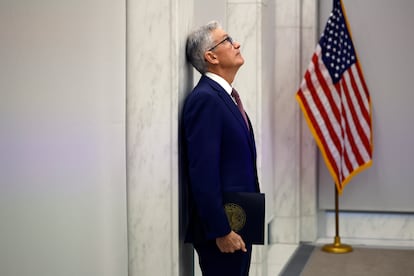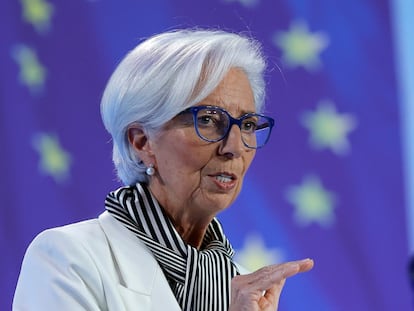Investors await clues from Powell on Fed’s rate reduction timing
The market is divided on whether there will be a cut at the institution’s first monetary policy meeting of the year on January 30-31


The U.S. economy has experienced a soft landing, as inflation loses steam without significantly affecting the labor market. Investors and analysts eagerly await Chair Jerome Powell’s insights on potential rate cuts at the Federal Reserve’s first monetary policy meeting of the year on January 30-31. Opinions are split on a potential 25-basis-point cut in the upcoming March meeting. However, it is widely believed that the Fed will maintain the current interest rate of 5.25%-5.50% in the January meeting, the highest in nearly 23 years.
The focus will be on Powell’s interpretation of the latest economic data. The economy grew by 0.8% in the fourth quarter of 2023 and 3.1% year-over-year, showing surprising strength. For the entire year, the gross domestic product (GDP) increased by 2.5%, according to the first estimate published on January 25 by the Commerce Department’s Bureau of Economic Analysis (BEA). In December, the Federal Reserve’s preferred inflation indicator slowed to 2.9%, falling below 3% for the first time since early 2021, according to BEA data published on on January 27.
Forecasts indicate a cooling of the U.S. economy this year. Inflation is above the 2% price stability target, but annualizing the data for the last three to six months would have already achieved that target. This sets the stage for rate cuts, but the question remains – when and at what pace to avoid missteps.
Political pressure
President Joe Biden has shown great respect for the Federal Reserve’s independent role in combating inflation. However, political pressure from Democrats for Powell to stimulate the economy in an election year is starting to surface.
Massachusetts Senator Elizabeth Warren, along with three other Democratic colleagues (John Hickenlooper of Colorado, Jacky Rosen of Nevada, and Sheldon Whitehouse of Rhode Island), have urged Powell to lower rates in order to make housing more affordable. “High interest rates have also worsened our nation’s housing supply crisis,” the senators wrote in a letter dated January 28. “As the Fed weighs its next steps in the new year, we urge you to consider the effects of your interest rate decisions on the housing market and to reverse the troubling rate hikes that have put affordable housing out of reach for too many.”
There is no indication that Powell, who was appointed by Donald Trump and reappointed by Joe Biden, will yield to political pressure. “We don’t think about politics. We think about what’s the right thing to do for the economy,” he said at the press conference after the December meeting. Regardless, any shift in monetary policy in an election year will likely draw criticism from some political interests.
While every word spoken by the Federal Reserve chair after the meeting concludes on January 31 will be carefully dissected, it’s possible that the Fed will move cautiously, considering the evolution of various economic indicators. The Fed can also use the tool of adjusting its balance sheet, which is currently being reduced after the pandemic expansion. For instance, it may decide to slow down the pace of asset reduction. This week, markets are closely monitoring the U.S. Treasury’s debt issuance goals, and how they could impact long-term interest rates and monetary conditions.
“If the Fed decides to cut rates in March, they will likely announce it during the meeting. However, the chances seem low as they may prefer to wait for more evidence of easing nominal wage growth and underlying inflationary pressures,” said analysts from Oxford Economics. “Downside risks to the economy are fading, reducing the need for the Federal Reserve to cut rates rapidly. This supports a gradual pace later this year. We expect the Fed to lower rates quarterly, starting in May.”
Axa Investment Managers expects a cautious easing of monetary policy, lowering rates to 4.75% by year-end, with the first cut in June. “If growth remains solid, we doubt that the Federal Reserve is completely confident that inflation will maintain a downward trend,” said Axa’s David Page.
Powell has repeatedly noted the danger of prematurely claiming victory and cited the example of Arthur Burns, the Federal Reserve chair in the 1970s who tolerated high inflation and allowed it to linger in the economy for 10 years. Powell, who openly admires Paul Volcker (Federal Reserve chair from 1979-1987), credits him with staying the course until price increases were finally brought under control in the 1980s.
The Federal Open Market Committee (FOMC) sets monetary policy and undergoes yearly changes in its composition. The FOMC consists of Powell, the other six Federal Reserve governors in Washington, D.C., and the president of the Federal Reserve Bank of New York. The remaining four voting positions rotate among the presidents of the regional Federal Reserve Banks. In 2024, the regional voting members are the presidents of the Federal Reserve Banks of Richmond (Tom Barkin), Atlanta (Raphael Bostic), Cleveland (Loretta Mester) and San Francisco (Mary Daly).
Sign up for our weekly newsletter to get more English-language news coverage from EL PAÍS USA Edition
Tu suscripción se está usando en otro dispositivo
¿Quieres añadir otro usuario a tu suscripción?
Si continúas leyendo en este dispositivo, no se podrá leer en el otro.
FlechaTu suscripción se está usando en otro dispositivo y solo puedes acceder a EL PAÍS desde un dispositivo a la vez.
Si quieres compartir tu cuenta, cambia tu suscripción a la modalidad Premium, así podrás añadir otro usuario. Cada uno accederá con su propia cuenta de email, lo que os permitirá personalizar vuestra experiencia en EL PAÍS.
¿Tienes una suscripción de empresa? Accede aquí para contratar más cuentas.
En el caso de no saber quién está usando tu cuenta, te recomendamos cambiar tu contraseña aquí.
Si decides continuar compartiendo tu cuenta, este mensaje se mostrará en tu dispositivo y en el de la otra persona que está usando tu cuenta de forma indefinida, afectando a tu experiencia de lectura. Puedes consultar aquí los términos y condiciones de la suscripción digital.
More information
Archived In
Últimas noticias
Most viewed
- Sinaloa Cartel war is taking its toll on Los Chapitos
- Oona Chaplin: ‘I told James Cameron that I was living in a treehouse and starting a permaculture project with a friend’
- Reinhard Genzel, Nobel laureate in physics: ‘One-minute videos will never give you the truth’
- Why the price of coffee has skyrocketed: from Brazilian plantations to specialty coffee houses
- Silver prices are going crazy: This is what’s fueling the rally










































